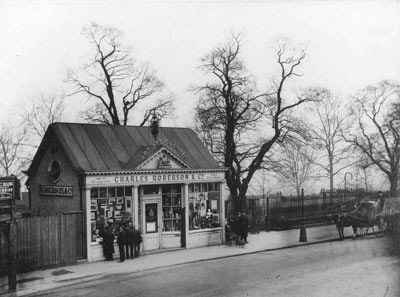Introduction
The Roberson Archive is the archive of the artists’ colourman Charles Roberson & Co. (1820─1985). Roberson was one of the most important colourmen in London in the nineteenth century and the material in the archive gives detailed information about both the internal workings of the company and its relations with its customers, suppliers and fellow colourmen.
In 1820 Charles Roberson opened his first shop on Long Acre, London, selling artists’ materials. Among his initial customers, comprising mainly professional artists and businesses related to the art trade, the name of Sir Thomas Lawrence, President of the Royal Academy, stands out. His custom is an early indication of the important position Roberson was to occupy in the nineteenth-century art world. Today, the company is less well known than its contemporaries Reeves, Rowney and Winsor & Newton, but in previous centuries it was one of the most influential colour houses in London, its customers spanning the social spectrum from Queen Victoria to theatrical scene painters. Although London-based, Roberson's goods were sold throughout the United Kingdom and were carried to many parts of the British Empire by architects, surveyors, soldiers and colonial administrators, as well as being used on Sir Ernest Shackleton's Antarctic expeditions and by Sir Howard Carter in Egypt. Despite the growing importance of the amateur market in the nineteenth century, professional artists, many of whom worked in London, were the company's most valued customers. Roberson’s were proud of the number of Royal Academicians and celebrated painters on their account books and their customers included Lawrence Alma-Tadema, Edward Burne-Jones, Elizabeth Butler, Frederic Leighton, John Millais, Dante Gabriel Rossetti, John Singer Sargent, Walter Sickert, James Tissot, James McNeill Whistler and members of the Pre-Raphaelite Brotherhood, the St John's Wood Clique and the Cranbrook Colony, as well as some of the great designers of the period including William Morris, William de Morgan, Gertrude Jekyll and Walter Crane.
The Roberson Archive
Roberson’s activities are known in detail because of the survival of their archive, now housed at the Hamilton Kerr Institute, Cambridge, as part of the Fitzwilliam Museum's manuscript collection. The recipe books, catalogues, letters, colour charts, pigments, paint boxes and over three hundred and sixty account ledgers dating from 1820 to 1944 form one of the largest artists’ colourman's archives in Britain. Many aspects of the history of the Victorian and Edwardian period can be traced through the Roberson Archive, but most importantly it provides a detailed record of the materials and techniques of nineteenth- and twentieth-century artists and designers at all levels across a wide range of disciplines.
Access
While the archives form an important collection of documents for research, they are inevitably vulnerable to damage from handling and are unsuitable for repeated consultation. Funding is therefore being sought for a future digitisation project to enable online access to these important but fragile records, providing a major multi-disciplinary research resource for the nineteenth and early twentieth centuries. The archive is therefore not accessible for research at the present time and we apologise that we are unable to answer queries on this material.
Index to the Roberson Archive
An index to the Roberson Archive, the most complete record that survives of a 19th century artists’ colourman, was published in 1997.

